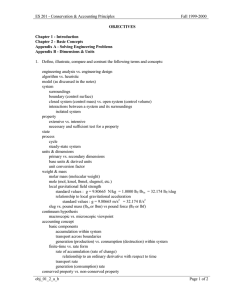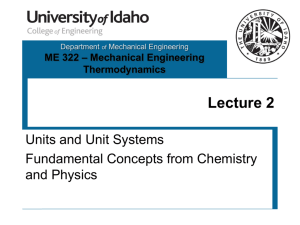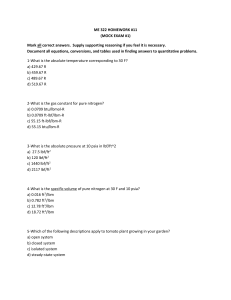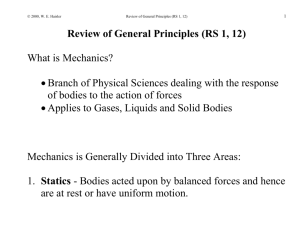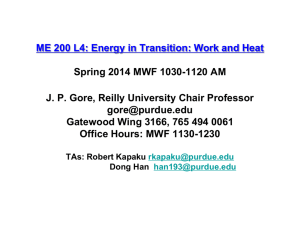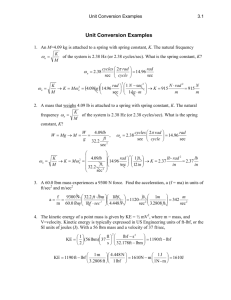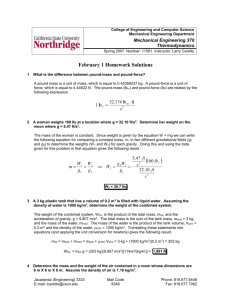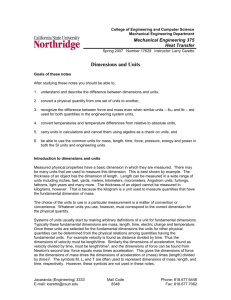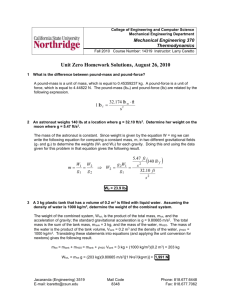Unit Systems - Michigan Technological University
advertisement
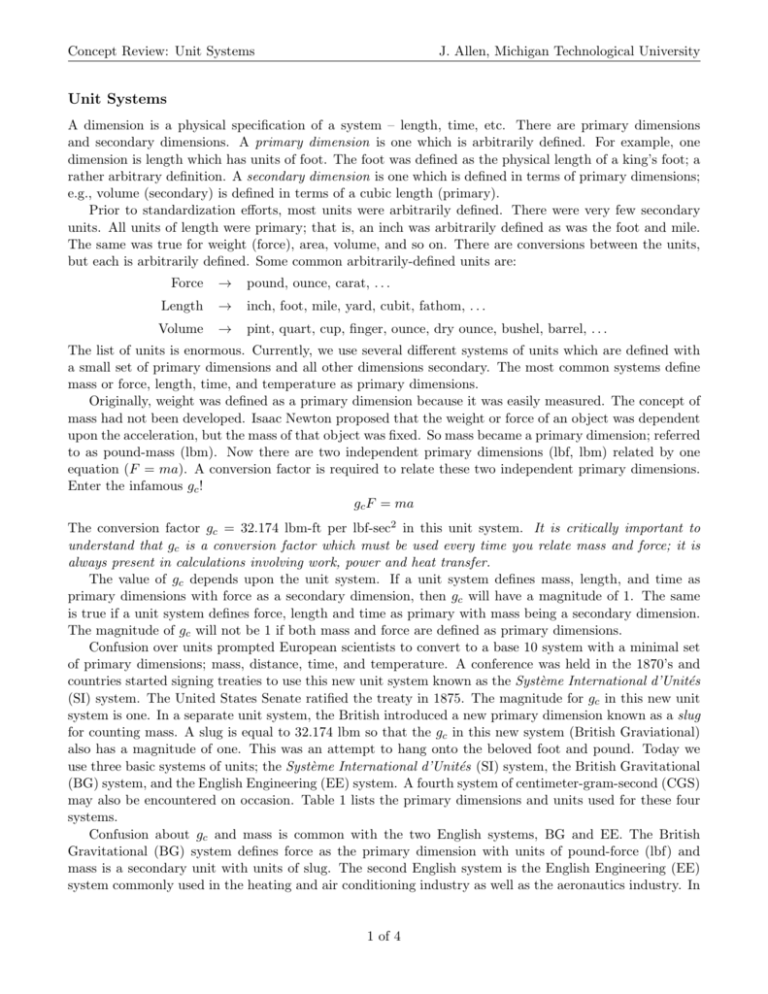
Concept Review: Unit Systems J. Allen, Michigan Technological University Unit Systems A dimension is a physical specification of a system – length, time, etc. There are primary dimensions and secondary dimensions. A primary dimension is one which is arbitrarily defined. For example, one dimension is length which has units of foot. The foot was defined as the physical length of a king’s foot; a rather arbitrary definition. A secondary dimension is one which is defined in terms of primary dimensions; e.g., volume (secondary) is defined in terms of a cubic length (primary). Prior to standardization efforts, most units were arbitrarily defined. There were very few secondary units. All units of length were primary; that is, an inch was arbitrarily defined as was the foot and mile. The same was true for weight (force), area, volume, and so on. There are conversions between the units, but each is arbitrarily defined. Some common arbitrarily-defined units are: Force → pound, ounce, carat, . . . Length → inch, foot, mile, yard, cubit, fathom, . . . Volume → pint, quart, cup, finger, ounce, dry ounce, bushel, barrel, . . . The list of units is enormous. Currently, we use several different systems of units which are defined with a small set of primary dimensions and all other dimensions secondary. The most common systems define mass or force, length, time, and temperature as primary dimensions. Originally, weight was defined as a primary dimension because it was easily measured. The concept of mass had not been developed. Isaac Newton proposed that the weight or force of an object was dependent upon the acceleration, but the mass of that object was fixed. So mass became a primary dimension; referred to as pound-mass (lbm). Now there are two independent primary dimensions (lbf, lbm) related by one equation (F = ma). A conversion factor is required to relate these two independent primary dimensions. Enter the infamous gc ! gc F = ma The conversion factor gc = 32.174 lbm-ft per lbf-sec2 in this unit system. It is critically important to understand that gc is a conversion factor which must be used every time you relate mass and force; it is always present in calculations involving work, power and heat transfer. The value of gc depends upon the unit system. If a unit system defines mass, length, and time as primary dimensions with force as a secondary dimension, then gc will have a magnitude of 1. The same is true if a unit system defines force, length and time as primary with mass being a secondary dimension. The magnitude of gc will not be 1 if both mass and force are defined as primary dimensions. Confusion over units prompted European scientists to convert to a base 10 system with a minimal set of primary dimensions; mass, distance, time, and temperature. A conference was held in the 1870’s and countries started signing treaties to use this new unit system known as the Système International d’Unités (SI) system. The United States Senate ratified the treaty in 1875. The magnitude for gc in this new unit system is one. In a separate unit system, the British introduced a new primary dimension known as a slug for counting mass. A slug is equal to 32.174 lbm so that the gc in this new system (British Graviational) also has a magnitude of one. This was an attempt to hang onto the beloved foot and pound. Today we use three basic systems of units; the Système International d’Unités (SI) system, the British Gravitational (BG) system, and the English Engineering (EE) system. A fourth system of centimeter-gram-second (CGS) may also be encountered on occasion. Table 1 lists the primary dimensions and units used for these four systems. Confusion about gc and mass is common with the two English systems, BG and EE. The British Gravitational (BG) system defines force as the primary dimension with units of pound-force (lbf) and mass is a secondary unit with units of slug. The second English system is the English Engineering (EE) system commonly used in the heating and air conditioning industry as well as the aeronautics industry. In 1 of 4 Concept Review: Unit Systems J. Allen, Michigan Technological University Table 1: Primary dimensions and units for common unit systems. primary dimension mass force length time temperature magnitude of gc Unit System SI kg – m s K BG – lbf ft s R EE lbm lbf ft s R CGS g – cm s ◦C 1 1 32.174 1 the EE system, both mass and force are defined as primary dimensions with units of pound-mass (lbm) and pound-force (lbf), respectively. The conversion factor, gc , has a value of 32.174 lbm-ft/lbf-s2 . Since gc has a magnitude equal to the gravitational acceleration, the magnitude of lbm and lbf are the same. In other words, in the EE system, 50 lbm would weigh 50 lbf under normal gravitational acceleration. A clear understanding of the difference between slug, lbm, and lbf is essential. Unit Conversion & Equivalency There are numerous secondary units in the field of energy and power. Some of the secondary units, particularly in the BG and EE unit systems, can be confusing. Below is a short list some secondary energy units. • British thermal unit [Btu]: defined as the energy required to raise the temperature of 1 lbm of water at 68 ◦ F by 1 ◦ F. • calorie [cal]: defined as the energy required to raise the temperature of 1 g of water by 1 ◦ C. Note that this is the steam table (IT) definition used by engineers and 1 cal = 4.1868 J which corresponds to the specific heat of water at 15◦ . Physicists use the thermodynamic calorie which is equal to 4.184 J and corresponds to the specific heat of water at 20◦ . Calorie (capital C) is used by nutritionists and is equal to 1000 IT calories. • 1 quad ≡ 1015 Btu; note that this is distinct from Q which is sometimes used for 1018 Btu. • 1 imperial gallon = 1.200 U.S. gallon • equivalent energy:1 1 barrel [1 bbl = 42 U.S. gal] of crude oil ≡ 460 lbm of coal ≡ 5680 SCF of natural gas ≡ 612 kWh of electricity (at ηth = 36%) 1 from Appendix B, Principles of Energy Conversion, 2nd ed., A. Culp, Jr., McGraw-Hill, Inc., 1991. 2 of 4 Concept Review: Unit Systems J. Allen, Michigan Technological University Conversion Factors Many sources for unit conversions are available in reference books and from the internet. A few basic conversions are provided here. proportionality constants: gc = 1 kg·m/N·s2 = 1 slug·ft/lbf·s2 = 32.2 lbm·ft/lbf·s2 J = 778.16 ft·lbf/Btu Length 1 ft = 12 in = 0.3048 m 1 mi = 5280 ft = 1609.344 m Force 1 lbf = 4.448222 N = 16 oz 1 dyne = 1.0 · 10−5 N Area 1 acre = 43,560 ft2 = 4046.9 m2 1 hectare (ha) = 10,000 m2 1 lbf/in2 = 6895 Pa 1 bar = 1.0 · 105 Pa Pressure Volume 1 = 0.028317 m3 1 U.S. gal = 231 in3 = 0.0037854 m3 ft3 1 1 1 1 Mass slug = 32.174 lbm = 14.594 kg lbm = 7000 grains short ton = 2000 lbm = 907.185 kg tonne = 1000 kg Energy 1 joule [J] = 1 N·m = 6.242×1018 eV = 0.737 ft·lbf Density 1 = 32.174 lbm/ft3 = 515.38 kg/m3 3 1 g/cm = 1000 kg/m3 slug/ft3 Viscosity 1 slug/ft·s = 47.88 kg/m·s [N·s/m2 ] 1 poise (P) = 1 g/cm·s = 0.1 kg/m·s Kinematic Viscosity 1 ft2 /s = 0.0929 m2 /s 1 stokes (St) = 1 cm2 /s = 0.0001 m2 /s 3 of 4 Concept Review: Unit Systems J. Allen, Michigan Technological University Prefixes Power of Ten Prefixes for Engineering Units mass length time volume pressure factor prefix symbol 1018 exa E 1015 peta P 1012 tera T 109 giga G GPa 106 mega M MPa 103 kilo k 102 hecto h 101 deka da 10−1 deci d 10−2 centi c 10−3 milli m 10−6 micro 10−9 GPa kg km kPa 100 = 1 d` cm mg mm ms m` µ µm µs µ` nano n nm ns n` 10−12 pico p ps p` 10−15 femto f 10−18 atto a fm fs a` specialty units 10−8 cm = Angstrom, Å, å 4 of 4
